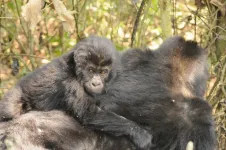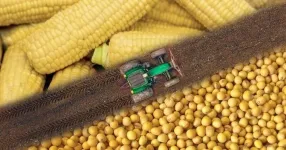(Press-News.org) New research shows transmission of the virus behind COVID-19 varies seasonally, but warmer conditions are not enough to prevent transmission.
The study, led by Imperial College London researchers and published today in Proceedings of the National Academy of Sciences, is the first to incorporate environmental data into epidemiological models of the transmission of SARS-CoV-2, the virus behind COVID-19.
The team show that temperature and population density are the most important factors determining how easily the virus spreads, but only in the absence of mobility-restricting measures, such as lockdowns.
First author of the study Dr Tom Smith, from the Department of Life Sciences at Imperial, said: "Our results show that temperature changes have a much smaller effect on transmission than policy interventions, so while people remain unvaccinated, governments mustn't drop policies like lockdowns and social distancing just because a seasonal change means the weather is warming up.
"However, our work also suggests that lower autumn and winter temperatures may lead to the virus spreading more easily in the absence of policy interventions or behavioural changes."
Seasonal variation has been a source of uncertainty in forecasts of SARS-CoV-2 transmission. Other viruses, like flu viruses and other coronaviruses, are known to be affected by environmental factors. For example, high temperatures and low humidity reduce the transmission of respiratory droplets, preventing the spread of flu. High temperatures are also known to inactivate other coronaviruses in the air and on surfaces.
However, quantifying the effects of environmental factors including temperature, humidity, and UV radiation (sunshine) on SARS-CoV-2 transmission has been difficult during the pandemic, since human factors like population density and behaviour have been the main drivers of transmission.
The differences in interventions and case-counting between countries and regions also makes comparing environmental factors on a global scale difficult, especially as some countries, like Brazil, India and Iran, have high transmission despite having warmer climates.
As a result, few epidemiological models have included environmental data, and those that do assume the response of SARS-CoV-2 is identical to other coronaviruses, as there is a lack of SARS-CoV-2-specific data.
To fill this gap, the team, from the Departments of Life Sciences and Mathematics at Imperial, as well as Imperial's MRC Centre for Global Infectious Disease Analysis, and Utah State University, compared transmission across the USA. The country has a large range of climates with comparable policies and case numbers, allowing the impact of environmental factors to be teased out.
They found strong evidence that lower temperature and higher population density are both associated with higher SARS-CoV-2 transmission.
Lead researcher Dr Will Pearse, from the Department of Life Sciences at Imperial, said: "While temperature and population density do influence SARS-CoV-2 transmission, our findings re-confirm that the most important drivers are public policy and individual behaviour. For example, during lockdowns, there was no meaningful signature of temperature influencing transmission.
"This means, for example, that warmer regions should not expect to ease mobility restrictions before colder regions. This is especially true as warmer regions tend to have higher population densities - for example, the population in Florida is more densely packed than in Minnesota."
The researchers are now extending their study to new variants, and say their environmental results should be incorporated into future forecasts to enhance predictions of disease spread.
Study co-author Dr Ilaria Dorigatti, from the MRC Centre for Global Infectious Disease Analysis at Imperial, said: "We found evidence that, in the early phases of the pandemic, places with colder temperatures were associated with higher SARS-CoV-2 transmission intensities. However, the effect of climatic seasonality on SARS-CoV-2 transmission is weaker than the effect of population density and in turn, of policy interventions.
"This implies that, as we move towards summer in the Northern Hemisphere, public health policy decisions remain of critical importance for epidemic control and adherence to recommendations will continue to play a key role against SARS-CoV-2 transmission."
INFORMATION:
KINSHASA, Democratic Republic of Congo (June 9, 2021) - A new study led by the Wildlife Conservation Society (WCS) has updated the global population estimate for the Critically Endangered Grauer's gorillas (Gorilla beringei graueri) - the world's largest gorilla subspecies- to 6,800 individuals from a previous global estimate of 3,800 individuals. This revised estimate comes from recent field surveys conducted in one of this animal's largest remaining strongholds, in areas that were previously inaccessible for surveys. However, these gorillas continue to be heavily impacted by ongoing insecurity, and by human incursion into their remaining habitat in eastern Democratic Republic of Congo.
Publishing in the American Journal of Primatology, ...
Researchers at Vanderbilt University Medical Center (VUMC) have identified a common mechanism underlying a spectrum of epilepsy syndromes and neurodevelopmental disorders, including autism, that are caused by variations in a gene encoding a vital transporter protein in the brain.
Their findings, reported last month in the journal Brain, suggest that boosting transporter function via genetic or pharmacological means could be beneficial in treating brain disorders linked to these genetic variations.
"This points (to) a clear direction of treating a wide spectrum of neurodevelopmental disorders, from various epilepsy syndromes (and) autism to neurodevelopmental delay and intellectual ...
June 9, 2021 - The first analysis of medical evidence on domestic mass shooters in the U.S. finds that a large majority of perpetrators have psychiatric disorders for which they have received no medication or other treatment, reports a study in the Journal of Clinical Psychopharmacology. The journal is published in the Lippincott portfolio by Wolters Kluwer.
"Without losing sight of the larger perspective that most who are violent are not mentally ill, and most of the mentally ill are not violent, our message is that mental health providers, lawyers, and the public should be made aware that some unmedicated patients do pose an increased risk of violence," according to the report by Ira D. Glick, MD, of Stanford University School of Medicine and colleagues.
In-depth analysis of ...
Smithsonian Conservation Biology Institute scientists are one step closer to understanding why some corals can weather climate change better than others, and the secret could be in a specific protein that produces a natural sunscreen. As their name implies, Hawaiian blue rice corals sport a deep blue pigment, which is created by chromoprotein and filters out harmful ultraviolet (UV) radiation from the sun. Although UV damage may produce long-term impacts to reproduction in many coral species--including brown rice coral--it may not have the same effect on blue rice coral. The findings of this study were published June 9 in ...
From 1980 to 2016, grain production in Brazil increased more than fourfold, and the country now stands as the world's largest soybean exporter and the second largest exporter of corn. The two main drivers of this increase in food production were cropland expansion and double-cropping, harvesting two crops, such as corn and soybeans, from the same field in a single year.
While cropland expansion has long been recognized as one of the drivers behind the increase in Brazil's agricultural output, a new study published in Nature Food quantifies for the first time the impact that double-cropping also ...
The fairy circles of the Namib are one of nature's greatest mysteries. Millions of these circular barren patches extend over vast areas along the margins of the desert in Namibia. In 1979, G.K. Theron published the first research about their origin. His hypothesis was that poisonous substances from Euphorbia damarana leaves induced fairy circles. As part of a new study, scientists from the University of Göttingen and the Gobabeb Namib Research Institute located the original euphorbia plants that were part of Theron's study. Four decades later, the researchers are now able to conclusively disprove Theron's original hypothesis. Their results were published in the journal BMC Ecology and Evolution.
In the late 1970s, South African botanist Theron noticed ...
A University of Oklahoma doctoral student, graduate and undergraduate research assistants, and an associate professor in the Homer L. Dodge Department of Physics and Astronomy in the University of Oklahoma College of Arts and Sciences are lead authors on a paper describing a "changing-look" blazar - a powerful active galactic nucleus powered by supermassive blackhole at the center of a galaxy. The paper is published in The Astrophysical Journal.
Hora D. Mishra, a Ph.D. student, and faculty member Xinyu Dai are lead authors of the paper, along with Christopher Kochanek and Kris Stanek at the Ohio State University and Ben Shappee at the University of Hawaii. The paper represents the findings of researchers from 12 different institutions who participated ...
Tsukuba, Japan - Holographic displays help add a three-dimensional--and thus more life-like--feel to what would otherwise appear as a two-dimensional image. Now, researchers in Japan have tested how this may work on a supramolecular level; such tests could lead to improved displays.
Commonly, one cannot overlay a certain type of molecular component that underlies helically arranged liquid crystals onto their molecular mirror images, much like a person cannot overlay their two hands and have them match up exactly without flipping one over. Molecules with this property are described as "chiral." Some materials make use of the principle of chirality to rotate light in a plane perpendicular to the direction of the light wave, known as circular ...
Researchers from the Singapore University of Technology and Design (SUTD) have developed novel techniques, known as Automated Fibre Embedding (AFE), to produce complex fibre and silicone composite structures for soft robotics applications. Their work was published in IEEE Robotics and Automation Letters.
Many soft robot components, including sensors and actuators, utilise embedded continuous fibres within elastomeric substrates to achieve various functionalities. However, manual embedding of continuous fibres in soft substrates is challenging due to the complexities involved in handling precise layering, and ...
Thermotherapy or heat treatment can help in treating lesions and other tissue injuries. For example, chemotherapy or radiotherapy, when combined with thermotherapy, kills tumorous cells more effectively. Thermotherapy is considered a promising approach for treating internal lesions, but the advancement in the field depends on the availability of patient-friendly heat-inducing devices capable of rapidly increasing the temperature of target tissues.
Current clinical practices around thermotherapy majorly employ heat-generating devices that are probed inside ...







